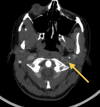Behind the Headache: A Case of Cerebral Venous Thrombosis Associated With Hormonal Contraceptive Use
- PMID: 40786304
- PMCID: PMC12334955
- DOI: 10.7759/cureus.87580
Behind the Headache: A Case of Cerebral Venous Thrombosis Associated With Hormonal Contraceptive Use
Abstract
Cerebral venous thrombosis is an uncommon but potentially life-threatening condition. We present the case of a previously healthy 26-year-old woman who developed cerebral venous thrombosis while using a combined hormonal contraceptive. She presented with progressive headaches unresponsive to analgesics. Imaging confirmed thrombosis in the left transverse and sigmoid sinuses and the left internal jugular vein. Anticoagulation was initiated with full resolution of symptoms and thrombus. Extensive thrombophilia screening was negative, and combined hormonal contraceptive use was identified as the main risk factor. The patient transitioned to a progestogen-only method. This case highlights the need to consider cerebral venous thrombosis in women with atypical headaches using combined hormonal contraceptives. It also emphasizes the importance of personalized contraceptive counseling based on thrombotic risk factors.
Keywords: adverse effects; case report; cerebral venous thrombosis; combined hormonal contraceptives; contraceptive counseling; secondary headache; venous thromboembolism.
Copyright © 2025, Sá et al.
Conflict of interest statement
Human subjects: Informed consent for treatment and open access publication was obtained or waived by all participants in this study. Conflicts of interest: In compliance with the ICMJE uniform disclosure form, all authors declare the following: Payment/services info: All authors have declared that no financial support was received from any organization for the submitted work. Financial relationships: All authors have declared that they have no financial relationships at present or within the previous three years with any organizations that might have an interest in the submitted work. Other relationships: All authors have declared that there are no other relationships or activities that could appear to have influenced the submitted work.
Figures


Similar articles
-
Risk of thromboembolism in patients with COVID-19 who are using hormonal contraception.Cochrane Database Syst Rev. 2023 Jan 9;1(1):CD014908. doi: 10.1002/14651858.CD014908.pub2. Cochrane Database Syst Rev. 2023. Update in: Cochrane Database Syst Rev. 2023 May 15;5:CD014908. doi: 10.1002/14651858.CD014908.pub3. PMID: 36622724 Free PMC article. Updated.
-
Unmasking hidden risks: cerebral venous sinus thrombosis and spontaneous subdural hematoma in women on oral contraceptives - insights from a case report and systematic literature review.Neurochirurgie. 2025 Jan;71(1):101603. doi: 10.1016/j.neuchi.2024.101603. Epub 2024 Oct 10. Neurochirurgie. 2025. PMID: 39388782
-
Combined hormonal contraceptive use among women with known dyslipidemias: a systematic review of critical safety outcomes.Contraception. 2016 Sep;94(3):280-7. doi: 10.1016/j.contraception.2015.08.002. Epub 2015 Aug 10. Contraception. 2016. PMID: 26272309
-
Cerebral Venous Sinus Thrombosis Associated With Contraceptive Use: A Case Report.Cureus. 2025 Jun 23;17(6):e86576. doi: 10.7759/cureus.86576. eCollection 2025 Jun. Cureus. 2025. PMID: 40704263 Free PMC article.
-
Steroidal contraceptives and bone fractures in women: evidence from observational studies.Cochrane Database Syst Rev. 2015 Jul 21;2015(7):CD009849. doi: 10.1002/14651858.CD009849.pub3. Cochrane Database Syst Rev. 2015. PMID: 26195091 Free PMC article.
References
-
- Sociedade Portuguesa da Contraceção, Sociedade Portuguesa de Ginecologia, Sociedade Portuguesa de Medicina de Reprodução. https://www.spdc.pt/images/2023/Consenso_de_Contraceo_versao_adoptada_pe... Consenso Sobre Contraceção 2020. 2023
-
- Cerebral venous thrombosis: 11 years in a stroke unit. Carneiro P, Damas C, Tavares J, Figueira M, Serra S, Guerreiro R, Matos R. RPMI. 2022;29:103–108.
-
- Direct oral anticoagulants versus warfarin in the treatment of cerebral venous thrombosis (ACTION-CVT): a multicenter international study. Yaghi S, Shu L, Bakradze E, et al. Stroke. 2022;53:728–738. - PubMed
-
- Cerebral venous thrombosis: an update. Ferro JM, Aguiar de Sousa D. Curr Neurol Neurosci Rep. 2019;19:74. - PubMed
Publication types
LinkOut - more resources
Full Text Sources
